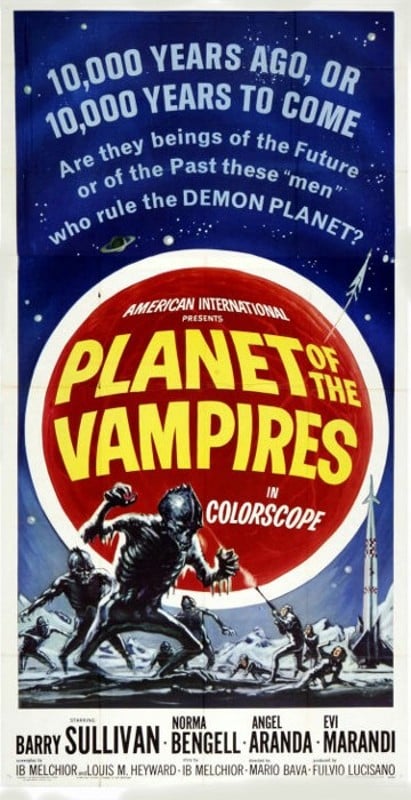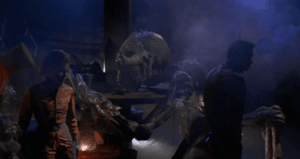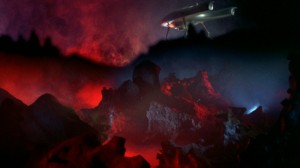 At first glance, ‘Planet of the Vampires’ could easily be mistaken for just another kitschy ‘60s sci-fi B-movie. But those “in the know” revere this movie as one of the very first crossover horror/sci-fi films, a front-runner for great movies like ‘Alien’ and ‘Event Horizon’ and that’s why it’s this week’s Thowback Thursday, ScienceFiction.com’s ongoing column to great science fiction of the past.
At first glance, ‘Planet of the Vampires’ could easily be mistaken for just another kitschy ‘60s sci-fi B-movie. But those “in the know” revere this movie as one of the very first crossover horror/sci-fi films, a front-runner for great movies like ‘Alien’ and ‘Event Horizon’ and that’s why it’s this week’s Thowback Thursday, ScienceFiction.com’s ongoing column to great science fiction of the past.
Filmed at Cinecittà Studios in Rome, the movie features an international cast and was shot by director Mario Bava on a shoestring budget – but Bava did such a great job of making the film look like a big production that you definitely wouldn’t think otherwise while watching it.
In the film, two large interplanetary exploration ships, the Argos and the Galliott, respond to a distress signal originating from the unexplored planet Aura. Upon their attempts to land, both crews become possessed by an unknown force and violently try to kill each other; only through the willpower and efforts of Captain Mark Markary (Barry Sullivan) commander of the Argos, is the Argos’ crew prevented from seriously injuring each other. Upon traversing the treacherous molten terrain of the planet to reach the now-unresponsive Galliott, Argos’ crew discovers that their comrades on the other ship were not as fortunate as they were; they lay strewn about the ship, apparently murdered by one another.
The unknown forces that originally possessed the Argos’ crew return, but instead of occupying the living survivors, the forces inhabit the bodies of the dead crew members, reanimating them from their hastily-constructed graves. While fending off the reanimated creatures and trying to fix the Argos so they can escape, Markary and the survivors come across a crashed alien ship housing huge skeletal remains of other aliens. The crew knows their situation is dire, and they are in a race against the clock to escape the force that has inhabited the bodies of their dead comrades. In a thrilling climax, much is revealed about the true nature of the unknown force, and the movie boasts not one but two inspired plot twists at the conclusion of the film that even I didn’t see coming!
The creation of the film itself has some amazing stories as well. The production was so pressed for time, the actors – who all came from a variety of international backgrounds – all spoke their lines in their native languages (including English, Portuguese, Italian, and Spanish), often times having no idea what the other actors were saying! This helps to explain the nagging sensation the viewer will encounter when it seems that some actors’ lines are dubbed into English, causing a disconnect between the actors’ mouth movements and what they are heard to be saying, while others appear in perfect synchronization.
Since the film was so groundbreaking for its time, the studio really had no idea what to name it. The original Italian title of the film, ‘Terrore Nello Spazio,’ translates to ‘Terror in Space;’ other titles attached to the movie in its various stages of pre- and post-production included ‘Planet of Blood,’ ‘Space Mutants,’ ‘The Demon Planet,’ ‘The Haunted Planet,’ ‘The Outlawed Planet,’ ‘The Planet of Terror,’ and ‘The Planet of the Damned.’ The confusion/indecision in naming the movie most likely came from the fact that the type of creatures portrayed in the film – reanimated humans possessed by an unknown force – had really never been clearly defined before this movie was released. Even though the film’s title is ‘Planet of the Vampires,’ the beings portrayed here are actually closer to zombies, but this film was released in 1965, three years before George Romero’s ‘Night of the Living Dead’ would adequately characterize this genre for us.
It is the originality of this film that really makes it a great movie-watching experience. At the time of its release, there really was no other film quite like it, as no other movie-makers were forward-thinking enough to put a truly scary film into the specifically-plotted confines of a science-fiction film. Even though the budget was fairly minimal (more on this below), each scene is more suspenseful and engaging than the last, drawing the viewer into the tale in an incredibly effective manner.
 One scene that Bava didn’t want to skimp on, however, was the sequence where Markary and two other crew members encountered a derelict alien spaceship. As the astronauts clambered around the large ship, they discovered multiple skeletal remains of gigantic, long-dead alien life forms. This scene draws immediate comparisons to the extended “space jockey” scene in Ridley Scott’s film ‘Alien,’ and rightfully so: produced 14 years after ‘Planet of the Vampires,’ Scott’s scene has a great deal of similarity to and evokes much of the same feel as the one presented in this movie. Upon the release of ‘Alien’ in 1979, the horror magazine Cinefantastique ran an article pointing out not only this obvious similarity but other minor parallels between the two films; both director Scott and screenwriter Dan O’Bannon claimed at the time that they had never seen ‘Planet of the Vampires.’
One scene that Bava didn’t want to skimp on, however, was the sequence where Markary and two other crew members encountered a derelict alien spaceship. As the astronauts clambered around the large ship, they discovered multiple skeletal remains of gigantic, long-dead alien life forms. This scene draws immediate comparisons to the extended “space jockey” scene in Ridley Scott’s film ‘Alien,’ and rightfully so: produced 14 years after ‘Planet of the Vampires,’ Scott’s scene has a great deal of similarity to and evokes much of the same feel as the one presented in this movie. Upon the release of ‘Alien’ in 1979, the horror magazine Cinefantastique ran an article pointing out not only this obvious similarity but other minor parallels between the two films; both director Scott and screenwriter Dan O’Bannon claimed at the time that they had never seen ‘Planet of the Vampires.’
The movie throws you right into the sci-fi-heavy mix, so there can be a little awkwardness early, depending on how quickly you as the viewer are able to get up to speed. Once you settle in, however, the interactions between the characters seem incredibly natural, a feat made even more impressive with the knowledge of the actors’ varied international backgrounds. Both the sci-fi and horror aspects of the plot seem very easy-flowing and not forced upon the viewer, as some films tend to do.
 As previously mentioned, the film was shot entirely working under a very minimalistic budget; it already looked remarkable (for its time), but Bava’s finished product is even more impressive with this knowledge. Extensive use of miniatures and “forced perspectives” are used in the film, including tons of colored fog on the planet’s surface to help hide the fact that they were actually just shooting on a bare-bones set. In an interview with Tim Lucas, Bava expounded on the process: “Do you know what that unknown planet was made of? A couple of plastic rocks — yes, two: one and one! — left over from a mythological movie made at Cinecittà! To assist the illusion, I filled the set with smoke.” According to Lucas, the two plastic rocks were multiplied in several shots by mirrors and multiple exposures. Bava must have been a true master of making do with what he had because the finished product on screen looks amazingly impressive.
As previously mentioned, the film was shot entirely working under a very minimalistic budget; it already looked remarkable (for its time), but Bava’s finished product is even more impressive with this knowledge. Extensive use of miniatures and “forced perspectives” are used in the film, including tons of colored fog on the planet’s surface to help hide the fact that they were actually just shooting on a bare-bones set. In an interview with Tim Lucas, Bava expounded on the process: “Do you know what that unknown planet was made of? A couple of plastic rocks — yes, two: one and one! — left over from a mythological movie made at Cinecittà! To assist the illusion, I filled the set with smoke.” According to Lucas, the two plastic rocks were multiplied in several shots by mirrors and multiple exposures. Bava must have been a true master of making do with what he had because the finished product on screen looks amazingly impressive.
Even without all of this fun background knowledge of the movie, ‘Planet of the Vampires’ is an incredibly rich story and a great viewing experience that has withstood the test of time and can easily entertain the “true genre fan” of today. I highly recommend you seek this movie out and give it a watch; you won’t be disappointed.

